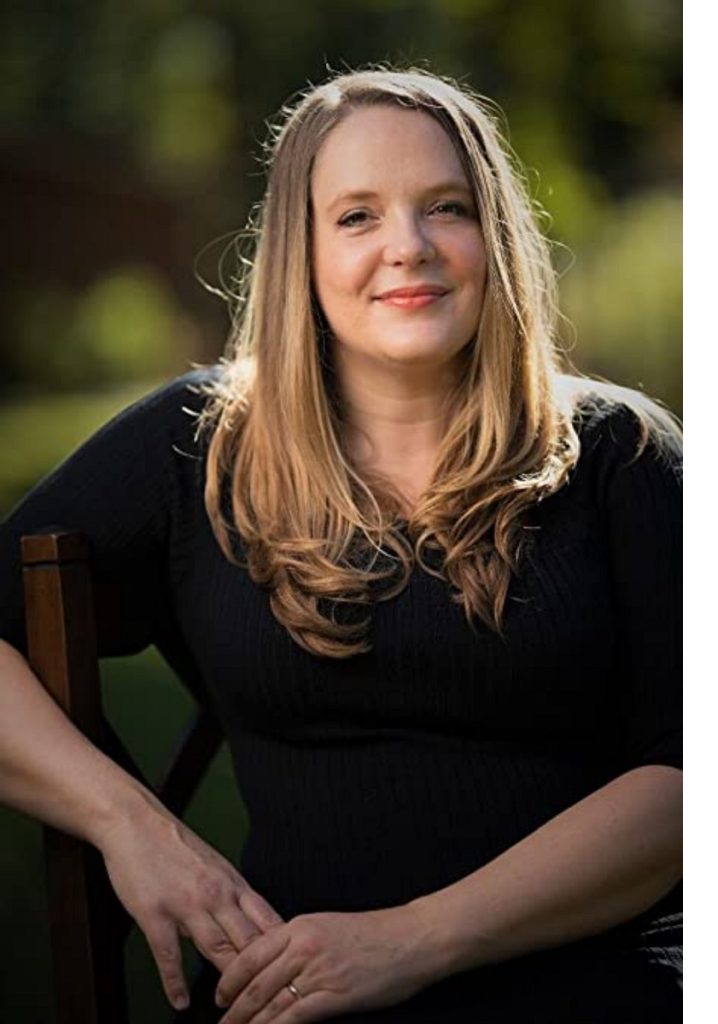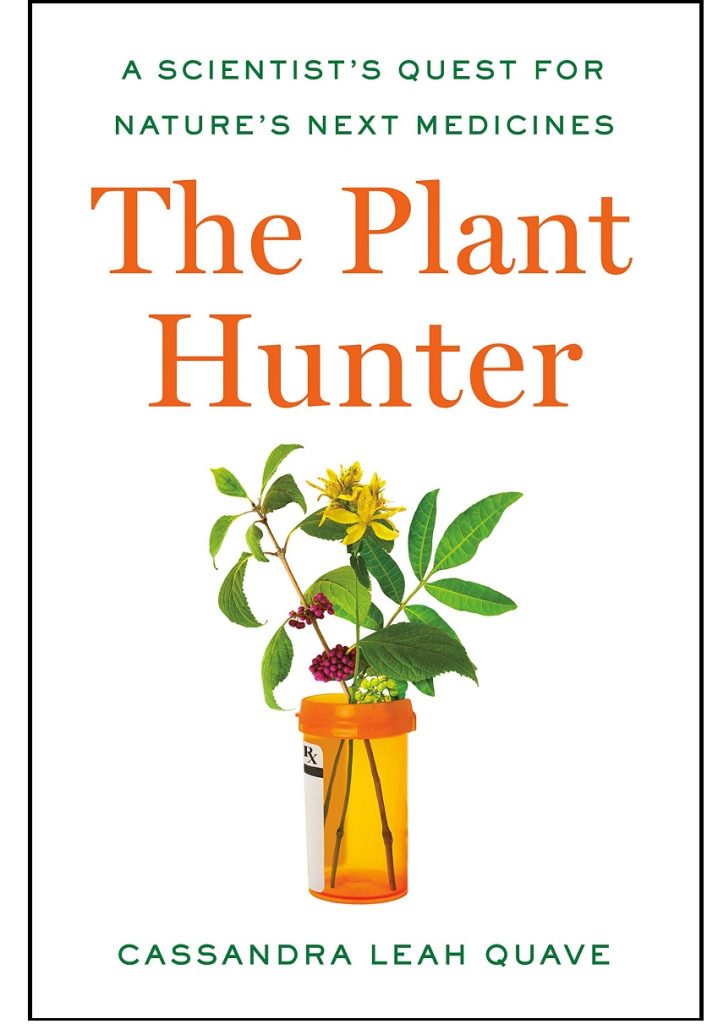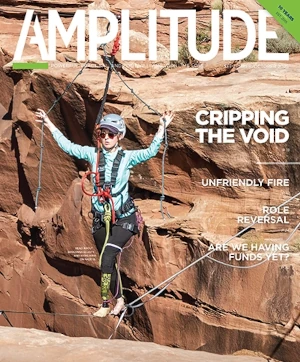Cassandra Quave’s medical education began in childhood. Born with congenital differences in her right leg, she had a below-knee amputation at age three; related orthopedic complications kept her (and her surgeons and prosthetists) busy for years thereafter.
She grew up strong and smart, with the intent of becoming a doctor. But a study-abroad trip to the Peruvian rain forest changed all that: Quave became fascinated with the healing practices and rites she saw in the Amazon basin, particularly the medicinal use of local plants. Instead of pursuing an MD, she went for a PhD in ethnobotany and is now a professor at Emory University, traveling the world to study the intersection between science, culture, and health.
It all makes for excellent reading in Quave’s new book, The Plant Hunter: A Scientist’s Quest for Nature’s Next Medicines. People with limb loss will find plenty to relate to in this memoir, but so will anybody who’s ever been sick a day in their life. Quave’s true subjects are more philosophical—the variety of ways in which humans define illness and disability, respond to it, and adapt to it, as well as the pros and cons of different approaches. “People often think of traditional medicine as this primitive form of medicine,” she tells Amplitude. “And I have to keep reminding them that the modern medicines you enjoy, most of those molecules were discovered in traditional healing cultures.”
We talked with Quave a few weeks ago about the book and her research. The conversation is edited for length and clarity. Order a copy of The Plant Hunter (and support global literacy) at Better World Books.
How did the book project get started?
We had some exciting scientific papers come out in the news, and that eventually led to a piece on my research in the New York Times Magazine [in 2016]. That profile opened a lot of doors. I’ve always wanted to write a book, because I think I’ve had a very unusual life experience compared to the average person. So when a literary agent approached me [after the Times article], I had to jump at it. It’s so hard to break into publishing, so I was super fortunate.
What objectives did you have in terms of the audience you wanted to reach and the message you wanted to put out in the world?
That’s a great question. I had a number of objectives, which made writing the book a bit challenging. First of all, I wanted to show the personal journey. There aren’t that many disabled people in science. One of the questions I keep getting asked by people is, “Why would you choose such a physically challenging area of work?” And the answer is that it’s my passion. It’s what makes me happy.
So one goal was to definitely tell the story of how my experience and journey through disability helped shaped my professional trajectory. And the other main objective was really to just share the knowledge and enthusiasm I have for the medicinal potential of plants, and the value of traditional knowledge and traditional medicine that’s largely still underexplored in science.

I also wanted to write something that’s readable. I’ve published over 100 scientific articles, so if people want to read the hardcore science, there’s plenty of that out there. I was trying to make something that’s informational and educational, but not a slog to get through.
Was it hard to shift gears from writing academese to writing for the average person?
The thing that helped me the most was my experience of working with undergraduates. They’re representative of the audience I was writing for, educated adults. So the ways I’ve learned to communicate science to them helped me.
When people ask you, “Why did you do this challenging work?” the underlying assumption is that you should have done something more “appropriate” for a person with a disability. Is that something that you’ve bumped up against routinely in your career?
Absolutely. I’m sure many of your readers have this experience. I’ve been an amputee since I was three years old. And before the leg was amputated I had limb-length disparity, missing bones, hip dysplasia, and really severe scoliosis. So in childhood it was always these very bold questions: “What’s wrong with you?” I got into this kind of desire to hide my disability, which was very difficult at the time because prosthetics didn’t look very lifelike. The limbs were very heavy and uncomfortable. I battled constant issues with skin infections. I was a very active kid, always outside, and yet the socks would just rub on the skin. So it was a challenge, this idea of trying to hide who I was.
It wasn’t until my mid-30s when I finally had enough of trying to hide that piece of me. I went to my prosthetist and said, “I’m going to strip it all down. I just want a metal pylon. I’m done with this, I’m tired of pretending.” He told me about these new artistic covers that were starting to come out, and I ended up getting a cover from the Alleles company. It just really helped flip the narrative for me, because as I travel, my leg is something I show off instead of being something I hide from people. Psychologically, it had a huge impact on me.
And it coincided with an important time in my career, when I was starting to break away and show what my real interests are. My research doesn’t necessarily fit within the classic drug-discovery paradigm. I’m really interested in plants and pharmacology and different ways of approaching disease. So [the Alleles cover] happened when I was stepping out professionally as well. [Ed: Alleles is coming out soon with a plant-themed prosthetic cover based on Quave’s work; keep your eyes peeled.]
You described how Don Antonio, the local healer you met in Peru while you were a student, helped to reorient you psychologically. It was a different outlook about disability—that [disability is] a gift as opposed to an impairment, a special kind of insight that is denied to the bulk of the population, and that benefits the community as a whole.
It is interesting how that identity can change from culture to culture. I had always seen medicine as just being about pharmacy and surgery, fixing whatever’s wrong. That’s all I had experienced. What [Don Antonio] taught me was that healing is about so much more. It’s about this human connection, connections in nature. It’s about the psyche and the spirit. And when it comes to the disabled identity, there are so many assumptions about what you can and can’t do, or should or shouldn’t do.
There was almost a spiritual component to the experience as you described it in the book. Do you feel people with disabilities have more of a connection to that spiritual dimension within themselves?
I think that through the experience of struggle with health, whatever your chronic health condition is, you have a different appreciation and different level of empathy. I just have a very easy way of relating with healers and with people who deal with illness because I’ve lived—not exactly their experience, but something of my own that I struggled through. You see this a lot in physicians who have struggled with their own medical issues and gone into medicine. That’s a big driver. I review a lot of medical school residency applications, and you see things like that again and again.
Another scene that spoke to spirituality was your encounter with the blow-dart hunter—how he tipped his darts with the same [plant-based] substance that forms the basis of medicines involved in your treatment throughout your life. It added an almost magical or mystical side to it.
People often think of traditional medicine as this primitive form of medicine. And I have to keep reminding them that the modern medicines you enjoy, most of those molecules were discovered in traditional healing cultures. It was amazing to see that and to know the full circle of that story. It was a really special moment.
Are there any plant-based medicines you’ve come across in your research that could really be helpful in managing common problems for amputees—skin problems, phantom pain, anything like that?
I haven’t really found anything that’s topical that helps me a lot besides botanical oils. I keep my stump moisturized with coconut oil and things like that. I’ve done a lot of research on botanicals for patients. That’s that’s one of the major areas of focus for research in my lab group. I’ve done a lot of studies on compounds that we’ve isolated from chestnut leaves, from elm leaf, blackberry, bush roots, and from pepper tree fruits that have some really nice activity. We actually have licensed one of those patents out to another company that’s developing it to deal with slow-healing or non-healing wounds.
There’s a lot of interest right now in the use of topical and oral CBD. I think the jury’s still out scientifically, but I’m interested in seeing where that goes. We’ve actually had a research project funded by the National Institutes of Health to look at terpenes, which are a technical relative of cannabis. We’ve been doing some studies with collaborators at Harvard to see if topical applications of this can help with certain forms of pain, but that’s still in progress. And I’m fascinated with psilocybin. A lot of the research on both cannabis and psilocybin has been stymied by very strict regulations around scientific research on it. But it seems like some of this is starting to change. I know there’s been a lot of work undertaken at Johns Hopkins on psilocybin.
Yeah, they have a center on it. UCSD is another institution where they’re looking at it.
I’m interested to see where that goes. When it comes to phantom leg pain, mine comes in weird spurts. I’ll go months without any problems, and then it’ll be a couple of days where it’s like I’ve got a lightning rod going zap, zap, zap, and it’s so uncomfortable. I just taught my lecture on hallucinogens today in my medical botany class, and we were talking about peyote and how important that is among Native American peoples of the Southwest and Midwest. It’s not used as a hallucinogen to feel high. It’s really a medicine to deal with trauma. And so I think there is a lot of hope within psychedelics. It’s not necessarily a cure for all ills, but within the right context, that could be something in the future.
I guess my note of caution is that [psychedelics] are not something that should be taken lightly. Some of these drugs are very powerful, and they have compounds that could have pretty severe interactions with other drugs. If you even take it with cough medicine, it could make you very, very ill. Not everything in nature is safe.
Do you feel as if the pandemic has given people a better understanding about our relationship with nature?
I think, or at least I hope, the pandemic taught us an important lesson: We really are a global family. It’s all connected. Something that happens on the other side of the world, a place you may never even come remotely close to, can actually have really serious consequences for your life. With the attention now on the virus, climate change, and the biodiversity crisis, people can become immune to the language of catastrophe. They don’t know what to do about it or how to deal with it, and they can start to feel hopeless.
If there’s any advice I can give to anyone that’s interested in connecting to the natural world, it’s to start in your backyard. Start in your neighborhood. Get to know the species you encounter every day but don’t know the names of. Just learning the names of the trees in your neighborhood, and then reading a little bit about how they may have been used in the past for food or medicine, that’s a great way to start. You don’t have to go to the remote Amazon to appreciate nature. Although it’s great if you do get to go there.




